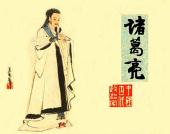Zhuge Liang (181-234 AD) Zhuge Liang with styled Kong Ming was an outstanding statesman and strategist in the Three Kingdoms Period. He was the symbol of wisdom, brilliance and genius. He was called “Crouching Dragon” in history.
Zhuge Liang was born in Yangdu County in Langya Commandery (today’s Yinan County, Shandong Province). He was the second of three brothers and | 
|
became orphaned at an early age. His uncle raised him and his brothers. When Cao Cao marched Shandong in 195, his family was forced to flee south and his uncle soon died of illness. For ten years he resided in Longzhong Commandery (today’s Hubei Province)with his brothers Zhuge Jin and Zhuge Jun, leading a simple peasant life – farming by day and studying at night. His reputation grew and he was nicknamed the “Crouching Dragon”, an indication of his wisdom in various fields.
Zhuge Liang married the daughter of Huang Chengyan, whose wife was the sister of Lady Cai (wife of the warlord Liu Biao and sister of Cai Mao). The name of Zhuge Liang's wife is rumored as Huang Yueying. The Huang family was also related to several other established clans in the region.
The warlord Liu Bei resided in the neighboring city Xiangyang (today’s Xiangfan City, Hubei Province) under Liu Biao, his distant relative and the governor of the Jing Zhou (today’s Jingzhou City, Hubei Province). Liu Bei visited Zhuge Liang personally for three times. Liu asked Zhuge to support him as counselor. At last, Zhuge Liang was moved and joined Liu Bei in 207. Zhuge Liang presented his Longzhong Plan to Liu Bei and travelled to Eastern Wu to form an alliance between Liu Bei and its ruler Sun Quan.
In the Battle of Red Cliffs of 208, the allied armies of Liu Bei and Sun Quan defeated Cao Cao, thus enabling Liu Bei and Sun Quan to establish their own kingdoms.
The historical novel Romance of the Three Kingdoms described Zhuge Liang calling forth a southeastern wind to enhance Huang Gai's fire-attack by spreading the flames across Cao Cao's ships. In reality, however, it was Zhou Yu, a famous general of Wu Kingdom who masterminded the fire attack. In folklore, the wind is attributed to either Zhuge Liang's magic or his ability to make accurate predictions of the weather.
After the death of Liu Bei, Zhuge Liang became the chancellor of Shu under Liu Shan, Liu Bei's son. He reaffirmed the alliance with Wu. Although Liu Bei suggested Zhuge Liang taking control of Shu if Liu Shan proved to be an incompetent leader, Zhuge declined the suggestion and continued to serve Liu Shan with unwavering loyalty.
The Three Kingdoms Period was a splitting and turbulent period in Chinese history, and it was also a time of heroes and nationalities’ fusion.
|